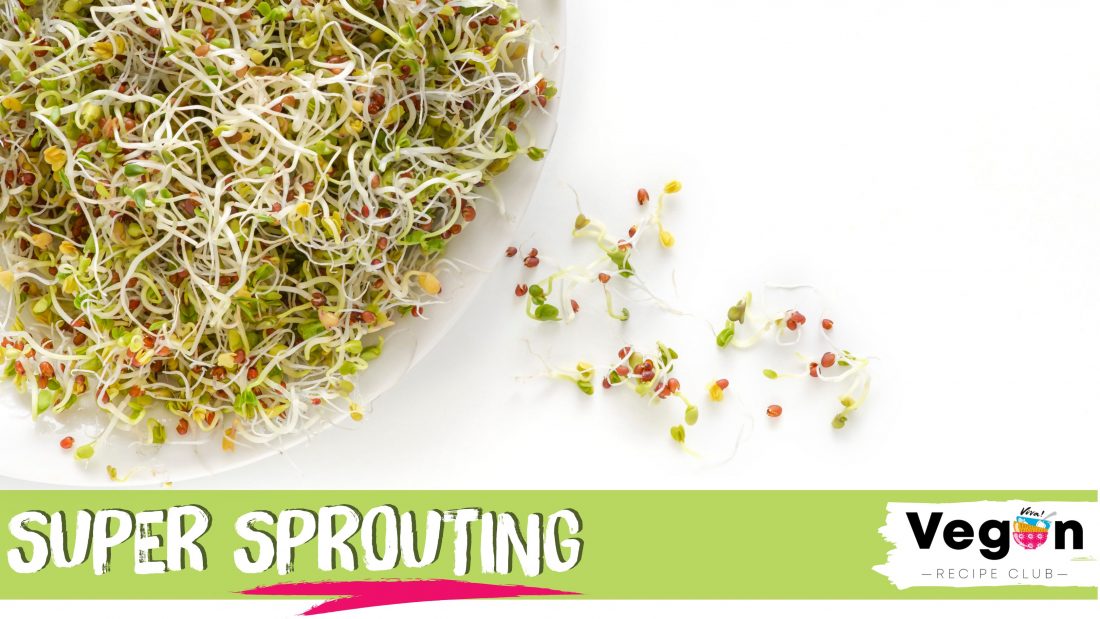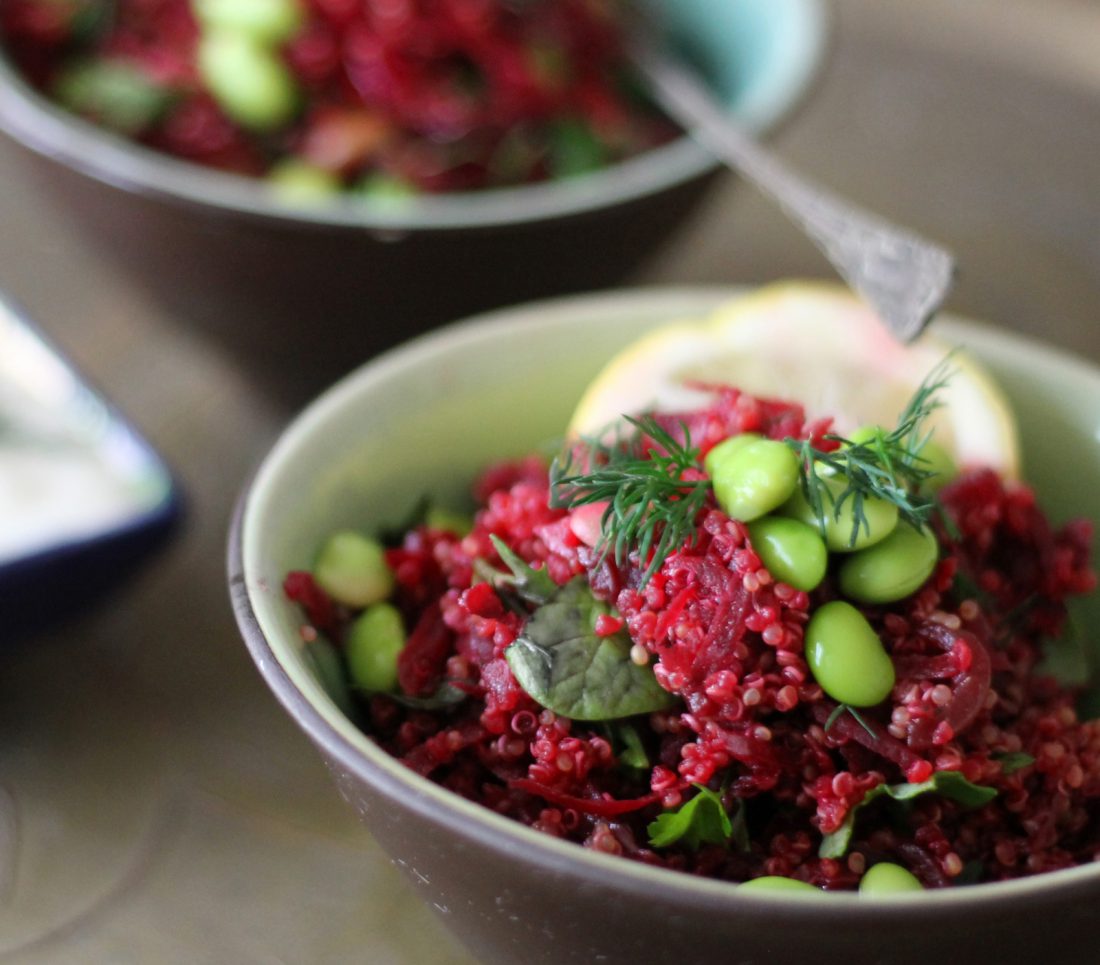Super Sprouting

Sprouted beans and seeds have long since lost their hippy image and are back with a cool new twist. It’s not just clever celebs in the know who are going for green!
Increasingly, more people want to get that energised feeling that plant power gives you – and sprouts tick all the boxes for freshness and nutrients. They are a great way of upping your vitamin intake and particularly good in winter when salad is both expensive and also uses lots of air miles to be flown in. We show you
- how to use sprouts
- where and what to buy
- how to grow your own sprouts, easily and cheaply
How to use sprouts
Try adding sprouted beans and seeds to some of our recipes, eg:
- In any mixed salad
- As part of a smoothie with other veg and fruit – eg using a Nutribullet or other high speed blender
- Warm Beetroot & Quinoa Tabbouleh – sprinkle a handful of your favourite sprouts on top as garnish
- Pauper’s Greens & Potato Soup – add a handful of lentil or chick pea sprouts to the soup when you blend it.
- With other salad ingredients in a veggieburger and bun
- In a salad wrap with hummus
- In Pumpkin & Lentil Soup or a raw soup recipe

Where and what to buy
Long Chinese bean sprouts are available from most supermarkets and Oriental stores (they’re grown from mung beans). They can be used in salads or Chinese, Thai and other Oriental cuisine such as stir-fried vegetables and tofu, pad thai etc. Store in the fridge and wash thoroughly before using. Add them last to hot dishes and don’t overcook – that way they keep more of their goodness!
![[node:title] [node:title]](/sites/default/files/styles/large/public/images/articles/beansprouts_chinese_asda.jpg)
Others types – sprouts like alfalfa, broccoli, purple radish or mixtures, can be bought from good health stores and greengrocers. Look for brands such as Aconbury or Sky. We’ve also seen sprouts in Sainsbury’s (Good4U lentil, pea & beanshoots) – and Ocado (Aconbury mixed sprouts)
![[node:title] [node:title]](/sites/default/files/styles/medium/public/images/articles/alfalfa_sprouts_acorn_brand_pic_from_planetorganic.jpg)
![[node:title] [node:title]](/sites/default/files/styles/medium/public/images/articles/sprouts_mixed_aconbury_ocado_pic.jpg)
Photos courtesy of Planet Organic, and Ocado respectively, with thanks
Grow your own sprouts
Home-sprouting is very easy, cheap and a brilliant way to get vital nutrients into your diet. Growing your own also means that you get organic food on the cheap. Just make sure the produce you buy isn’t past its sell-by date so the little darlings germinate and grow!
![[node:title] [node:title]](/sites/default/files/styles/medium/public/images/articles/bean_sprouting_wikihow.jpg)
- Time for sprouts varies according to the size of the seed/pulse, but is usually just a few days. Grow in small batches that you can use quickly while fresh. One teaspoon of seeds makes astonishing quantities! With pulses, try a tablespoon of mung beans, chick peas or a mixed variety to get an idea of quantities.
- Don’t mix seeds with pulses because they germinate at different times due to size differences. Once you get the hang of it, you can rotate sprouts so you always have a small but fresh supply growing and another batch ready to eat.
- The ‘Wednesday and Sunday’ rule is useful: soak the first batch on a Sunday, rinse and drain the next day and continue until sprouted. They’ll be ready by about Wednesday – then start the process again.
What to grow?
- Small seeds: alfalfa, clover, radish or fenugreek are all good. Aconbury Sprouts sell a range of seeds – or try a good health food shop
- Large seeds: sunflower, pumpkin
- Pulses: whole lentils, aduki beans, mung beans or chick peas – obviously, the larger the bean, the longer it takes to sprout.
- Mixed packs of pulses or seeds are available especially for sprouting. These add variety; particularly if you are sprouting for one or two people.
AVOID AT ALL COSTS
Kidney beans – poisonous if not boiled for at least 15 minutes. In fact, most large beans are a bit indigestible when sprouted – the exception being chickpeas. Stick to small beans or whole lentils!
How to grow sprouts
Basic method, jar or tray
- Soak the beans or seeds overnight, preferably in filtered water.
- Drain and rinse with fresh water twice daily – again, use filtered water if possible. This process is something that’s easily done first thing while the kettle is boiling for your morning cuppa and in the evening during dinner prep or clear up.
- If using the jar method, tip upside down so that any excess water drains out of the cheesecloth top or slotted lid.
- Rinse and drain for 2-4 days or until the sprouts start to appear. If using a jar, keep it upside down – dish-drying racks are good for keeping jars tilted but stable. If you are using a tray sprouter, just
- remember to empty the bottom tray so the drained water doesn’t overflow. (NB This water is good for watering houseplants or garden pots.)
- When watering, shake gently so the seeds don’t get stuck on the sides of the jar, but be careful not to damage the delicate new sprouts.
- Keep the jars on a reasonably warm work surface or draining board but away from direct sunlight.
- As a rule of thumb, seeds take just a day or two, while beans take a little longer.
- If sprouts start to go mouldy, throw them away. This may happen occasionally if the seeds/pulses are diseased or old or if the temperature has become too hot and they haven’t been rinsed
- sufficiently.
- Once they are sprouted, rinse them and keep in the fridge. Eat as quickly as possible.
Jar method
For beans and larger seeds, clean, wide-mouthed glass jars are best– use fairly large jars because they expand as they grow. Plus…
- elastic bands
- some circles of cheesecloth or j-cloths – bigger than the circumference of the jars
- small quantities of whole pulses or seeds, as above.
- a water filter if possible (this makes the seeds more likely to sprout, especially if your tap water is heavily chlorinated)
When you’ve washed the seeds/pulses of your choice, place each type in a separate jar, put the cheesecloth/j-cloth over the top, pull it tight across and secure on the neck of the jar with an elastic band.

Tray method
For small seeds, sprouting trays/germinators are best – they can get waterlogged and go mouldy in jars. They come in various sizes
![[node:title] [node:title]](/sites/default/files/styles/medium/public/images/articles/sprouting_tray_biosnacky_0.jpg)
Sprouting jars, trays and seeds are fairly inexpenive to buy. Biosnacky sprouting jars are great because they have a tilting lid that lets them drain easily. (I leave mine on the draining board!) Find them in good health food shops or online eg Goodness Direct or Realfoods
![[node:title] [node:title]](/sites/default/files/styles/medium/public/images/articles/biosnacky-glass-germinator_avogel.png)

The author
This post was written by VRC Team
Vegan Recipe Club is part of the UK’s leading vegan charity, Viva!. We have hundreds of delicious vegan recipes; from easy weeknight dinners to showstopper desserts, and everything in-between! Keep your eyes peeled for new recipes each month developed by our expert team of foodies and from guest chefs too.
